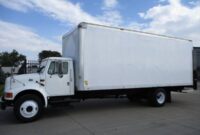Chicken Litter Spreader Trucks For Sale: A Comprehensive Guide to Smart Investment pickup.truckstrend.com
The backbone of sustainable agriculture and efficient nutrient management, chicken litter spreader trucks are indispensable assets for modern poultry operations and crop farmers alike. These specialized vehicles transform a potential waste product – chicken manure – into a valuable, organic fertilizer, closing the nutrient loop and fostering healthier soils. For anyone in the agricultural sector looking to enhance soil fertility, reduce synthetic fertilizer costs, and manage poultry waste responsibly, investing in a chicken litter spreader truck is a decision with significant long-term benefits. This comprehensive guide delves into everything you need to know when considering "Chicken Litter Spreader Trucks For Sale," from understanding their function to making an informed purchase.
Understanding Chicken Litter Spreader Trucks
Chicken Litter Spreader Trucks For Sale: A Comprehensive Guide to Smart Investment
At its core, a chicken litter spreader truck is a heavy-duty vehicle designed to efficiently and uniformly distribute poultry litter across agricultural fields. It typically consists of two main components: a robust truck chassis and a specialized spreader body mounted on its back.
How They Work:
The magic happens within the spreader body. Chicken litter, a mixture of manure, bedding material (like wood shavings or rice hulls), and sometimes feathers, is loaded into the truck’s hopper. A conveyor system, usually a heavy-duty chain-and-slat floor or a live bottom system, moves the material towards the rear. At the back, a series of powerful beaters (either horizontal or vertical) shred and break up the litter, ensuring a consistent texture. Finally, spinner discs or a wide-spreading mechanism propel the finely processed litter evenly across the field. The entire operation is often powered by the truck’s power take-off (PTO) unit or an independent hydraulic system, allowing for precise control over spread width and application rate.
Essential for Modern Agriculture:
These trucks are vital for several reasons:
- Nutrient Cycling: They facilitate the return of essential nutrients (nitrogen, phosphorus, potassium, and micronutrients) from poultry waste back to the soil, where they can be utilized by crops.
- Waste Management: They provide an effective and environmentally sound method for managing the large volumes of litter generated by poultry farms.
- Cost Savings: By utilizing organic fertilizer, farmers can significantly reduce their reliance on expensive synthetic fertilizers.

The Benefits of Owning a Chicken Litter Spreader Truck
Investing in a dedicated chicken litter spreader truck offers a multitude of advantages, impacting both the economic viability and environmental sustainability of agricultural operations.
-
Economic Advantages:
- Reduced Fertilizer Costs: The most direct benefit is the substantial saving on synthetic fertilizer purchases. Poultry litter is a complete fertilizer, providing a slow-release source of nutrients that improves soil structure over time.
- Increased Crop Yields: Proper application of litter enhances soil fertility, microbial activity, and water retention, leading to healthier crops and potentially higher yields.
- Potential for Custom Spreading Services: If you have excess capacity, you can offer custom spreading services to neighboring farms, generating additional income.

-
Environmental Benefits:
- Sustainable Nutrient Management: Litter spreading is a cornerstone of sustainable agriculture, recycling nutrients and reducing the environmental footprint of farming.
- Improved Soil Health: Organic matter from litter improves soil structure, aeration, and water infiltration, while also buffering pH levels. This leads to healthier, more resilient soil ecosystems.
- Reduced Chemical Runoff: Relying less on synthetic fertilizers can decrease the risk of nutrient runoff into waterways, protecting aquatic ecosystems.
-
Operational Efficiency:
- Timely Application: Owning your spreader allows for precise timing of applications, optimizing nutrient uptake by crops and fitting into your specific farming schedule.
- Uniform Spreading: Modern spreader trucks are designed for highly uniform distribution, ensuring all parts of the field receive the intended amount of nutrients.
- Labor Savings: Efficient machinery reduces the manual labor involved in waste handling and fertilizer application.
-
Versatility: Many chicken litter spreaders are versatile enough to handle other organic materials such as compost, dairy manure, and even some types of municipal biosolids, adding to their utility.

Types of Chicken Litter Spreader Trucks
The market for chicken litter spreader trucks offers a diverse range of options, each suited for different scales of operation and specific needs. Understanding these types is crucial for making an informed purchase.
-
By Chassis Type:
- Straight Trucks (Single, Tandem, Tri-Axle): These are self-contained units where the spreader body is permanently mounted on a truck chassis.
- Single Axle: Smaller capacity, highly maneuverable, suitable for smaller farms or tighter fields.
- Tandem Axle: Mid-range capacity, common, good balance of capacity and maneuverability.
- Tri-Axle: Larger capacity, best for extensive operations and longer hauls, but less agile.
- Pull-Type Spreaders: These are towed by a tractor or another large vehicle. While not "trucks" in the self-propelled sense, they are often used in conjunction with trucks for transport. They are typically more affordable initially.
- Semi-Trailer Mounted Spreaders: The largest capacity options, designed to be pulled by a semi-truck tractor. Ideal for very large farms or commercial spreading operations covering vast acreage.
- Straight Trucks (Single, Tandem, Tri-Axle): These are self-contained units where the spreader body is permanently mounted on a truck chassis.
-
By Spreading Mechanism:
- Horizontal Beaters with Spinner Discs: The most common type for litter. Horizontal beaters at the rear finely process the material, which then falls onto rotating spinner discs that broadcast it over a wide pattern (up to 60-80 feet). This provides a very uniform and wide spread.
- Vertical Beaters: These beaters rotate vertically, shredding and throwing the material directly behind the truck. They are excellent for breaking up clumps and can handle wetter, more challenging materials. The spread pattern is generally narrower but can be very robust.
- Chain/Slat Floor vs. Live Bottom/Push-Off:
- Chain/Slat Floor: A heavy-duty chain system with slats pulls the material towards the beaters. Durable and widely used.
- Live Bottom/Push-Off: A hydraulic ram pushes a false front wall, or a conveyor belt system moves the entire load to the rear. Less prone to bridging with very sticky materials but can be more complex.
-
By Capacity: Spreaders are rated by their carrying capacity, typically measured in cubic feet or tons. Options range from small 10-ton units to massive 30+ ton commercial spreaders. Your farm size, litter production, and acreage to be fertilized will dictate the ideal capacity.
-
New vs. Used:
- New Trucks: Offer the latest technology, full warranties, and no wear-and-tear issues. Higher initial investment.
- Used Trucks: Significantly lower initial cost, but require thorough inspection. Can be a great value if well-maintained.
Key Considerations When Buying a Chicken Litter Spreader Truck
Purchasing a chicken litter spreader truck is a significant investment that requires careful thought. Here are crucial factors to consider to ensure you make the right choice for your operation.
- Capacity Requirements: Assess your current and future needs. How much litter do you generate? How many acres do you need to cover? Over- or under-sizing can lead to inefficiencies or unnecessary costs.
- Spreading Mechanism Suitability: Consider the type of litter you’ll be spreading (dry, wet, with bedding) and your desired spread pattern. Horizontal beaters with spinners are best for wide, uniform dry litter application, while vertical beaters might be better for clumpy, wetter material.
- Chassis and Drivetrain:
- Road vs. Field Use: Will the truck primarily operate on fields or also on public roads? This impacts legal weight limits, tire choice, and road-worthiness features.
- Terrain: If your fields are hilly or muddy, you’ll need a truck with good traction, possibly all-wheel drive, and adequate horsepower.
- Transmission: Automatic transmissions offer ease of use, while manual transmissions might offer more control for some operators.
- Condition (Especially for Used Trucks): This is paramount.
- Frame Integrity: Check for cracks, severe rust, or previous repairs.
- Spreader Body: Inspect the floor chain/conveyor, beaters, spinner discs, and side walls for wear, corrosion, and damage. These are high-wear components.
- Hydraulics & PTO: Ensure all hydraulic lines are free of leaks and the PTO engages smoothly.
- Engine & Transmission: Look for signs of proper maintenance, oil leaks, and listen for unusual noises.
- Tires & Brakes: Critical for safety and performance.
- Maintenance and Parts Availability: Choose a reputable brand with readily available parts and a strong dealer network for service and support. Downtime during spreading season can be costly.
- Technology Features: Modern spreaders can come equipped with GPS mapping, variable rate control (VRC) systems, and weigh scales. These technologies optimize nutrient application, minimize waste, and improve record-keeping. While they add to the cost, they can significantly boost efficiency and environmental compliance.
- Regulatory Compliance: Be aware of local, state, and federal regulations regarding manure application, including setback distances from waterways, nutrient management plans, and road weight limits.
- Budget: Determine your budget and stick to it. Factor in not just the purchase price, but also potential transport costs, insurance, and initial maintenance.
Tips for Buying a Chicken Litter Spreader Truck
Navigating the market for chicken litter spreader trucks, whether new or used, requires a strategic approach. Here are practical tips to guide your purchase.
- Thorough Research is Key: Before you even look at a truck, research different manufacturers (e.g., Chandler, New Leader, BBI Spreaders, Kuhn Knight, Meyer), models, and their reputations. Read reviews and talk to other farmers who own spreaders. Understand common issues with specific models.
- Inspect Diligently, Especially Used Equipment: Never buy a used truck sight unseen. If possible, visit the seller.
- Bring a Checklist: Go through all major components: frame, engine, transmission, axles, tires, brakes, hydraulic system, PTO, spreader box integrity, floor chain/conveyor, beaters, spinners, and controls.
- Look for Wear and Tear: Pay close attention to high-wear areas like the floor chain and beaters. Excessive wear here can indicate high usage or poor maintenance.
- Check for Rust: Litter is corrosive. Look for significant rust on the frame, body, and critical components.
- Fluid Leaks: Inspect for oil, hydraulic fluid, or coolant leaks.
- Get a Mechanic’s Opinion: If you’re serious about a used truck, invest in a pre-purchase inspection by a qualified heavy equipment mechanic. They can identify hidden problems.
- Request Maintenance Records: For used trucks, a detailed service history is invaluable. It indicates how well the previous owner maintained the machine and can reveal recurring issues.
- Test Drive/Operate: If possible, ask to see the truck in operation, ideally spreading some material. This allows you to check if all systems (conveyor, beaters, spinners) function correctly and if the controls are responsive. Listen for unusual noises.
- Negotiate: Don’t be afraid to negotiate the price, especially on used equipment. Be prepared to walk away if the price isn’t right or if too many issues are present.
- Consider Transportation Costs: Factor in the cost of transporting the truck to your farm, especially if purchasing from a distant seller.
- Understand Your Financial Options: Explore financing options through agricultural lenders or equipment dealerships. Weigh the pros and cons of outright purchase versus financing.
Challenges and Solutions
While highly beneficial, owning and operating a chicken litter spreader truck can present certain challenges. Being aware of these and knowing potential solutions can help you mitigate risks.
- High Initial Cost:
- Challenge: New spreader trucks represent a significant capital expenditure.
- Solution: Explore the used market for well-maintained equipment, consider leasing options, or look into financing tailored for agricultural machinery. For smaller operations, a pull-type spreader might be a more budget-friendly entry point.
- Maintenance Demands:
- Challenge: Chicken litter is corrosive and abrasive, leading to wear on components, especially the floor chain, beaters, and spinners. Regular maintenance is crucial.
- Solution: Implement a strict preventive maintenance schedule. Regular cleaning (especially after use), greasing, chain tension checks, and timely replacement of worn parts will extend the lifespan of your investment. Keep a stock of common wear parts.
- Odor Management:
- Challenge: Spreading chicken litter can generate odors, especially in populated areas.
- Solution: Apply litter during periods of low wind, incorporate it into the soil immediately after spreading (if practical), and communicate with neighbors about your spreading schedule. Consider less odorous litter types if possible.
- Compaction Issues:
- Challenge: Heavy trucks can cause soil compaction, especially in wet conditions.
- Solution: Use proper tire inflation pressure, consider flotation tires, spread when soil moisture is optimal (not too wet), and if possible, use controlled traffic farming techniques.
- Regulatory Hurdles:
- Challenge: Nutrient management plans, permitting requirements, and environmental regulations can be complex and vary by location.
- Solution: Work closely with your local agricultural extension office, state environmental agencies, or a certified nutrient management consultant to ensure full compliance. Stay updated on all relevant regulations.
Chicken Litter Spreader Trucks For Sale: Estimated Price Table
Please note: The prices listed below are estimates and can vary significantly based on brand, model, age, condition, features, market demand, and geographical location. This table is intended as a general guide.
| Type of Truck (Condition) | Capacity (Approx. Tons) | Spreading Mechanism | Chassis Type | Estimated Price Range (USD) | Key Features / Notes |
|---|---|---|---|---|---|
| Used (Fair Condition) | 10-15 | Horizontal Beaters/Spinners | Tandem Axle | $25,000 – $60,000 | Older model, higher hours, some wear on components, may require immediate repairs. Good for smaller operations or as a backup. |
| Used (Good Condition) | 15-25 | Horizontal/Vertical Beaters | Tandem/Tri-Axle | $60,000 – $120,000 | Well-maintained, moderate hours, good working order, possibly some minor cosmetic wear. Excellent value for mid-sized operations. May include basic GPS. |
| Used (Excellent/Refurb) | 20-30+ | Horizontal/Vertical Beaters | Tri-Axle/Semi-Mount | $120,000 – $250,000 | Low hours, recently refurbished or extensively maintained, near-new condition. Often includes advanced features (VRC, GPS). Suitable for large farms or commercial services. |
| New (Standard Model) | 15-25 | Horizontal Beaters/Spinners | Tandem/Tri-Axle | $180,000 – $350,000+ | Brand new, full warranty, standard features. Reliable performance, latest emissions standards. Price varies greatly by brand and specific model. |
| New (High-Capacity/Advanced) | 30-45+ | Horizontal/Vertical Beaters | Tri-Axle/Semi-Mount | $350,000 – $600,000+ | Top-of-the-line models, large capacity, advanced technology (GPS, VRC, integrated scales), heavy-duty construction. Designed for large-scale commercial operations requiring precision and high throughput. |
Frequently Asked Questions (FAQ) about Chicken Litter Spreader Trucks
Q1: How often should I spread chicken litter?
A1: The frequency depends on several factors: the amount of litter generated, the nutrient needs of your crops, soil test results, and local regulations. Generally, litter is applied before planting or as a top-dress during the growing season. Soil testing is crucial to avoid over-application and nutrient runoff.
Q2: What are the most common maintenance tasks for these trucks?
A2: Regular maintenance includes daily cleaning of the spreader body (especially beaters and chains), greasing all moving parts, checking hydraulic fluid levels and hoses, inspecting the floor chain tension, checking tire pressure and condition, and routine engine/transmission servicing as per the manufacturer’s recommendations.
Q3: Can chicken litter spreader trucks spread other materials?
A3: Yes, most chicken litter spreaders are versatile enough to spread other organic materials like compost, dairy manure, beef manure, lime, and sometimes even gypsum or other soil amendments, depending on the specific spreader design (e.g., beater type).
Q4: What permits or regulations do I need to be aware of when spreading chicken litter?
A4: Regulations vary significantly by location (state, county, local). You may need a nutrient management plan, permits for land application, and adhere to setback distances from waterways, wells, and residences. It’s crucial to consult your local agricultural extension office or environmental agency.
Q5: How do I determine the correct spreading rate for my fields?
A5: The correct spreading rate is determined by a combination of factors: soil test results (indicating existing nutrient levels), the nutrient content of your chicken litter (which can vary), and the nutrient requirements of your target crop. Many modern spreaders offer variable rate control (VRC) systems that use GPS to adjust application rates automatically across the field based on prescription maps.
Q6: What is the typical lifespan of a chicken litter spreader truck?
A6: With proper maintenance, a well-built chicken litter spreader truck can last 10-20 years or even longer. The lifespan of the spreader body components (chains, beaters, floor) will often be shorter than the chassis and may require periodic replacement.
Conclusion
Chicken litter spreader trucks are more than just pieces of farm equipment; they are integral components of a sustainable and economically sound agricultural strategy. They transform a significant byproduct into a valuable resource, enriching soil, reducing input costs, and contributing to a healthier environment. When considering "Chicken Litter Spreader Trucks For Sale," a thorough understanding of your operational needs, a diligent approach to inspection, and an awareness of market dynamics will empower you to make an investment that yields returns for years to come. By choosing the right machine, you not only enhance your farm’s productivity but also strengthen its commitment to responsible stewardship of the land.
:max_bytes(150000):strip_icc()/__opt__aboutcom__coeus__resources__content_migration__mnn__images__2020__03__rhode-island-hen-7f9b1b93dba8401999c52f85096fbe6c.jpg)


